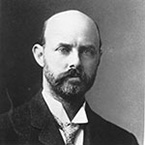
Frank B. Mallory was the co-author, with J. Homer Wright, of Pathological Technique, the standard textbook and a laboratory bible for a generation of pathologists. It embodied his insistence on clarity and conciseness of exposition and adequate illustrations, which also characterized his writings. He imposed those standards on those who would publish in the Journal of Medical Research, which became the American Journal of Pathology in 1925. He served as editor-in-chief from 1923 to 1940.
Known for dedication to medical education, Dr. Mallory took a personal interest in the development of the young pathologists who trained under him. He impressed on each of them the value of scientific accuracy and the horror of careless technique. His trainees included future AACR leaders S. Burt Wolbach, Thomas Ordway, Shields Warren, Fred W. Stewart, and Cornelius P. Rhoads.
Dr. Mallory was educated at Harvard University, receiving his undergraduate degree in 1886 and his medical degree in 1890, and joined the Harvard Medical School faculty in 1890. He was professor of pathology at Harvard from 1928 to 1932. He was also long associated with the department of pathology of Boston City Hospital, since renamed the Mallory Institute of Pathology in his honor. In conjunction with his training responsibilities, he devoted his time to improving histologic technique, working out new staining methods, and upgrading the classification of tumors, particularly meningiomas and lesions involved in alcoholic cirrhosis of the liver. He also confirmed the bacillus discovered by Jules Bordet as the causative agent in whooping cough.
He was president of the AACR in 1911 and again in 1929. He also served on various important committees, including a committee for drafting a constitution for the organization, which was adopted in January 1912, and a committee for considering means to educate the public. He served as president of the American Association of Pathologists and Bacteriologists in 1910 and was the recipient of numerous honors and awards, including the Kober medal for outstanding service in pathology from the Association of American Physicians in 1935. When he died in 1941, Dr. Mallory left to pathologists and bacteriologists throughout the world a lasting legacy of the rewards to be found in following scientific curiosity with enthusiasm, care, and accuracy toward the goal of medical progress.